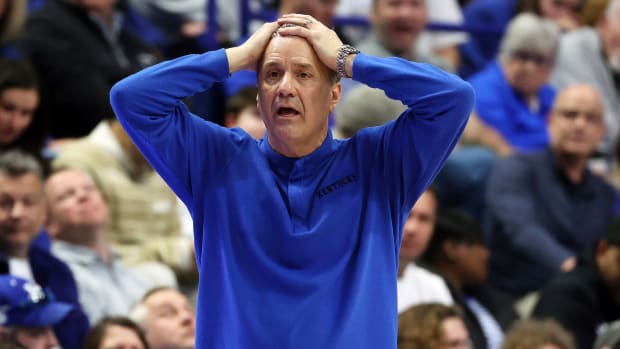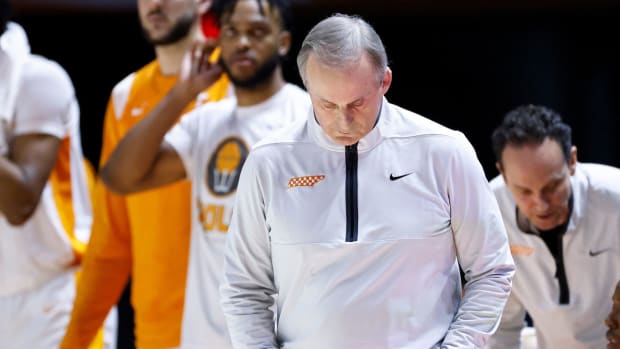Forty names, games, teams and minutiae making news in men’s college basketball, where Portland State hit the Game Winner of the Year on Saturday:
SECOND HALF: NMSU’s Mess
First Half
Welcome to Stress Month
If you’ve just emerged from the football bunker, welcome. Some stuff has been happening over here in college basketball. In fact, you might not recognize the place.
We are less than a month away from Selection Sunday, and the stress is rising in some interesting locations. There is bubble stress for bluebloods. There is top-of-the-rankings stress for teams that have had very good seasons but now are starting to wobble. There is good stress for a few programs that have put themselves in unexpectedly strong positions.
Time to apply a Minutes Stress Test:
In terms of bubble stress, we can argue which blueblood bust should be feeling more of it between Kentucky and North Carolina. Goodness knows, the NCAA and its corporate partners would love to have both in the bracket come March 12—maybe against each other in the Mother of All First Four games in Dayton—but the available data makes it a tough sell at the moment. Let’s dig in to both:
Kentucky (1), fourth in the preseason AP Top 25, almost assuredly would be out if today were Selection Sunday. The Wildcats are 16–9 overall, 7–5 in the Southeastern Conference, No. 46 in the NCAA NET rankings, No. 44 in the Pomeroy Ratings. And the trend line is down. Sharply.
The road upset of Tennessee is doing a lot of work on the Kentucky résumé. All the work, really. The Wildcats may need to go 4–2 or better the rest of the regular season—which won’t be easy with road games against Mississippi State, Florida and Arkansas, and home games against Tennessee, Auburn and Vanderbilt. Then win at least one in the SEC tournament.
Even then, the Cats would be 21–12 and sweating out Championship Week developments elsewhere. That’s not the existence John Calipari (2) sold the fan base, as his tenure continues to sour.

James Crisp/AP
Kentucky was barely in the field heading into the weekend, then lost to Georgia, which is tied for 10th in the SEC and had lost six of its previous seven. Kentucky was without two of its top seven players in Sahvir Wheeler and CJ Fredrick, but let’s be honest here: Fans had been howling for months to get Wheeler out of the lineup, and Fredrick is a spot-up shooter who isn’t making buckets (30.2% in SEC play outside the arc)—if the Cats couldn’t beat Georgia without those two, it’s a bad loss.
Fact is, Calipari is perpetually at risk of being shorthanded because he keeps his rotation tight and rarely develops players in-season. Sophomore big man Daimion Collins was a five-star signee who shows flashes but only plays sporadic minutes. Freshman guard Adou Thiero is a break-glass-in-case-of-emergency backup. Calipari touted freshman center Ugonna Onyenso after beating Michigan in early December, saying, “I’ve got to play Ugonna,” but he’s logged a total of 28 minutes in the 17 games since then. Veteran post player Lance Ware hasn’t taken off his warmups since January.
You wonder where this team might be if, say, Calipari had given Bryce Hopkins (3) a chance to contribute more last season and kept him around. After averaging 2.1 points and 6.4 minutes in 2021–22 at Kentucky, Hopkins transferred to Providence and became a star. He’s producing 16.6 points, 9.2 rebounds and 2.4 assists per game for the Friars.
If there is a bigger disappointment than Kentucky, it’s North Carolina (4), the preseason No. 1 team after returning four-fifths of its starting lineup from the run to the national championship game. The Tar Heels (16–9, 8–6 in the Atlantic Coast Conference) are No. 40 in the NET, No. 32 Pomeroy and an ugly 0–8 in Quad 1 games.
Carolina did help itself over the weekend by blowing out Clemson in Chapel Hill. That ended a three-game losing streak that was punctuated by a beatdown at Wake Forest—which the Heels wallpapered over to a degree with a late scoring flurry to lose by only eight. Like Kentucky, UNC might need to finish 4–2 or better against a solid closing stretch (Miami, Virginia and Duke at home; North Carolina State, Notre Dame and Florida State on the road), then avoid a first-game flameout in the ACC tourney.
Carolina needs all of its core four returnees to be less mercurial and more reliable down the stretch, especially guard Caleb Love (5). The Heels might also benefit from a little more Puff Johnson in the rotation and a little less Pete Nance, even if that means sacrificing some size.
Hubert Davis (6) has three weeks to get North Carolina in position for another postseason push. Until then, he’s fighting the perception that he caught lightning in a bottle in another otherwise undistinguished two years replacing Roy Williams.
The other guy on Tobacco Road replacing a legend is having his own struggles—on the court and with the officials. That’s Jon Scheyer (7), whose Duke team followed up the home revenge win over North Carolina with consecutive losses last week to Miami and Virginia.
The Blue Devils (17–8, 8–6 in the ACC) are better positioned than Kentucky or North Carolina in terms of NCAA résumé. They are No. 31 in the NET, No. 36 in Pomeroy and have a little more meat on the nonconference bone with neutral-court wins over Xavier and Iowa. But a road record of 2–6 is problematic, albeit mitigated by a bollixed endgame situation (8) at Virginia Saturday.
The ACC hastily issued a statement Saturday night saying its officials blew a call that should have resulted in a foul on Virginia’s Ryan Dunn and Duke’s Kyle Filipowski (9) shooting two free throws with a chance to break a tie. Instead, the shot attempt was waved off, and the game went into overtime, where the Cavaliers won. (The ACC statement is itself somewhat confusing, since it cites a scenario from the NCAA Casebook that relates to “a game without a courtside monitor.” This game clearly had a monitor available.)
The ACC statement likely was intended to help Duke’s NCAA tourney case and mitigate any damage caused by a second straight loss. But the outcome underscores the fact that life on the road is different without Mike Krzyzewski’s commanding presence with the refs, and that the Blue Devils are looking at a middling NCAA seed at the moment.
Filipowski had his two lowest-scoring games since December last week, producing nine points against Miami and taking the bagel against Virginia. He also had eight turnovers in the two games. If he’s hitting the freshman wall at all, the return of Dariq Whitehead after missing the previous four games with injury could be fortuitous timing.
Wisconsin (10) is another NCAA tournament regular feeling major bubble anxiety at the moment. The Badgers (14–10, 6–8 in the Big Ten), who have only missed one Big Dance since 1998, have lousy metrics, ranking 80th in the NET and 70th in Pomeroy. But they also have a 5–6 record in Quad 1 games—far better than Kentucky and North Carolina, among others—with a quintet of solid wins away from home, against Marquette, Iowa, USC, Dayton and Penn State.
However, the last time we saw Wisconsin it was losing to the Big Ten’s 12th-place team, Nebraska. The Badgers are 3–8 in their last 11 games. The upcoming three-game home stand against Michigan, Rutgers and Iowa is of paramount importance to stay in the NCAA picture.
After a dreamy start, New Mexico (11) is spiraling toward the wrong side of the bubble. The Lobos (19–6, 6–6 in the Mountain West) have lost four of their last five and were routed Friday night by Air Force, which shouldn’t happen.
New Mexico has two big wins on the résumé, beating Saint Mary’s and San Diego State on the road, and has the relative strength of its league (Ken Pomeroy rates the Mountain West sixth nationally, ahead of the ACC). But the selection committee probably remembers the MWC’s flop in last year’s tournament, too. New Mexico certainly needs to win more than it loses down the stretch.

Wade Payne/AP
Top seed stress:
Tennessee (12) is now finding ways to lose instead of win. The Volunteers were shocked by buzzer beaters twice last week, upset on the road by Vanderbilt and at home by Missouri. Credit those opponents for making hard shots to win, but blame the Vols for giving them a chance to win at the end.
Santiago Vescovi (13), a career 80% foul shooter, missed a front-end free throw with eight seconds left to open the door for Vandy. Then against Missouri, a Vescovi missed foul shot with four seconds left was followed by a Tennessee lane violation that wiped out one he made, giving the Tigers the ball down two. DeAndre Gholston’s launch from about 30 feet won it at the buzzer.
Flukish outcomes? Maybe. But with three losses in the last four games, Tennessee is off the No. 1 seed line for sure, perhaps off the No. 2 line, and trending toward a No. 3 seed.
Purdue (14) has gone from the clear No. 1 team in the country to perhaps hearing footsteps in the Big Ten. The Boilermakers (23–3, 12–3 in the league) are suddenly turnover prone, giving away the ball 49 times in their last three games—two of them losses, and the third a shaky finish against Iowa’s full-court press.
There is no reason to take Purdue off the top seed line at present. But there may be a developing blueprint for playing the Boilers: pressure the guards and swarm giant Zach Edey (15), because they will lose the rock.
Out West, Arizona (16) is showing a proclivity for not respecting every opponent and thus being vulnerable to eyebrow-raising upsets. The Wildcats (22–4, 11–4 in the Pac-12) have losses to Utah (No. 52 in the NET), Washington State (No. 81), Oregon (No. 50) and now Stanford (No. 105).
Arizona needs the more consistent UCLA (17) to drop a game between now and their March 4 showdown in Pauley Pavilion for the Wildcats to have a shot at the Pac-12 regular-season title. Arizona has a lot of good wins that will help it in the selection committee room, but it could be losing ground in the race for a No. 1 seed and favorable geographic location.
Bubble arriviste stress:
Oklahoma State (18) has surged into contention with a five-game winning streak, most notably beating Iowa State in Ames on Saturday. A winning record in the brutal Big 12 should all but assure a berth, and the Cowboys are getting there at 7–5. Oklahoma State has been to only one men’s NCAA tournament since 2017.
Memphis (19) has won seven of its last eight and has nonconference wins over Auburn and Texas A&M to support its at-large argument. The Tigers are riding the geriatric duo of 26-year-old forward DeAndre Williams (17.5 points, 8.2 rebounds) and 23-year-old guard Kendric Davis (21.8 points, six assists) but have some tough sledding ahead with two games remaining against No. 2 Houston.







